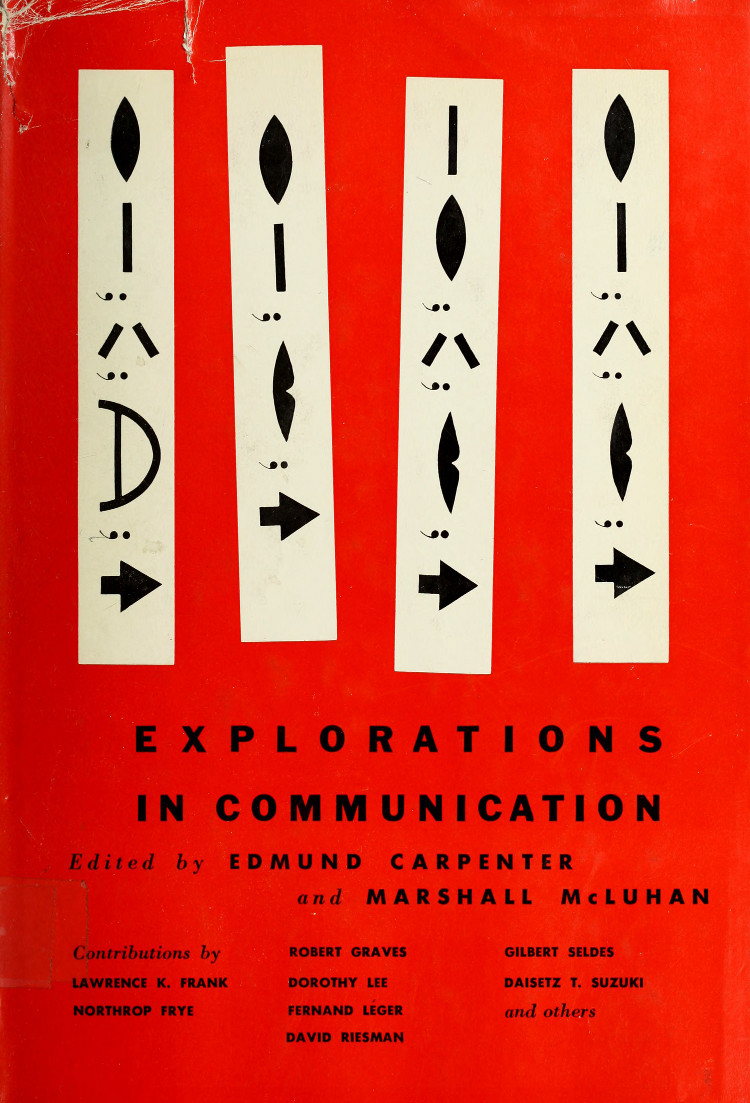Edmund Carpenter, Marshall McLuhan (eds.): Explorations in Communication: An Anthology (1960–) [EN, ES]
Filed under book | Tags: · communication, communication technology, language, mass media, media, media theory, print, technology, television

“This book explores the form and dynamics of communication to discover how it works – how human beings exchange feelings, facts, fancy. What makes words, sentences and grammars meaningful? What is the difference between the private world of reading and the instant “togetherness” of television audiences? How does the inner structure of communication vary from society to society?
These essays by world-famed scholars and artists cover the whole range of communications media — from skin touch to voice inflection, from newsprint to electronic devices, from primitive grammars to films. Here we step outside the various media by examining one through another. Print is seen from the perspective of electronics; television is analyzed through print — and thus literacy’s role in shaping man is brought into sharp new focus.
The contemporary revolution in the packaging and distribution of ideas and feelings makes a new view of communication imperative. To give voice to such views, the journal Explorations was begun in Toronto in 1953, financed by the Ford Foundation and the Toronto Telegram. From the start, the magazine won high praise from the academic world. The articles in this book, all of which appeared in Explorations, represent some of the most original research now in print on problems that will confront us for many years to come.” (from front flap)
With contributions by Ray L. Birdwhistell, Edmund Carpenter, H. J. Chaytor, Lawrence K. Frank, Northrop Frye, Arthur Gibson, Sigfried Giedion, Stephen Gilman, Robert Graves, Stanley Edgar Hyman, Dorothy Lee, Fernand Léger, Marshall McLuhan, David Riesman, W. R. Rodgers, Gilbert Seldes, Jean Shepherd, Daisetz T. Suzuki, Jacqueline Tyrwhitt.
Publisher Beacon Press, Boston, 1960
Issue 218 of Beacon series in Contemporary Communications
210 pages
via Archive.org
Explorations in Communication: An Anthology (hi-res, 181 MB, no OCR), Lower-res version (67 MB, OCR, via Steve McLaughlin), Other formats
El aula sin muros investigaciones sobre técnicas de comunicación (Spanish, trans. Luis Carandell, 2nd ed., 1968/1974, added on 2014-3-6)
Erkki Huhtamo, Jussi Parikka (eds.): Media Archaeology: Approaches, Applications, and Implications (2011)
Filed under book | Tags: · cinema, computing, machine, media, media archeology, media theory, psychoanalysis, technology, telepathy

“This book introduces an archaeological approach to the study of media – one that sifts through the evidence to learn how media were written about, used, designed, preserved, and sometimes discarded. Edited by Erkki Huhtamo and Jussi Parikka, with contributions from internationally prominent scholars from Europe, North America, and Japan, the essays help us understand how the media that predate today’s interactive, digital forms were in their time contested, adopted and embedded in the everyday. Providing a broad overview of the many historical and theoretical facets of Media Archaeology as an emerging field, the book encourages discussion by presenting a full range of different voices. By revisiting ‘old’ or even ‘dead’ media, it provides a richer horizon for understanding ‘new’ media in their complex and often contradictory roles in contemporary society and culture.”
Publisher University of California Press, Berkeley, CA, 2011
ISBN 0520262743, 9780520262744
x+356 pages
Reviews: Simone Natale (Canadian Journal of Communication, 2012), Sarah Lugthart (TMG, 2012), John Potts (Screen, 2013), Michael Goddard (Journal of Visual Culture, 2013), Swagato Chakravorty (Senses of Cinema, 2013), Astrid Mager (Information, Communication & Society, 2013).
PDF (updated on 2021-4-9)
Comment (1)Alexander R. Galloway: The Interface Effect (2012)
Filed under book | Tags: · aesthetics, computing, ideology, interface, media, media theory, mediation, ontology, philosophy, politics, software

“Interfaces are back, or perhaps they never left. The familiar Socratic conceit from the Phaedrus, of communication as the process of writing directly on the soul of the other, has returned to center stage in today’s discussions of culture and media. Indeed Western thought has long construed media as a grand choice between two kinds of interfaces. Following the optimistic path, media seamlessly interface self and other in a transparent and immediate connection. But, following the pessimistic path, media are the obstacles to direct communion, disintegrating self and other into misunderstanding and contradiction. In other words, media interfaces are either clear or complicated, either beautiful or deceptive, either already known or endlessly interpretable.
Recognizing the limits of either path, Galloway charts an alternative course by considering the interface as an autonomous zone of aesthetic activity, guided by its own logic and its own ends: the interface effect. Rather than praising user-friendly interfaces that work well, or castigating those that work poorly, this book considers the unworkable nature of all interfaces, from windows and doors to screens and keyboards. Considered allegorically, such thresholds do not so much tell the story of their own operations but beckon outward into the realm of social and political life, and in so doing ask a question to which the political interpretation of interfaces is the only coherent answer.
Grounded in philosophy and cultural theory and driven by close readings of video games, software, television, painting, and other images, Galloway seeks to explain the logic of digital culture through an analysis of its most emblematic and ubiquitous manifestation – the interface.”
Publisher Polity, 2012
ISBN 0745662528, 9780745662527
170 pages
Review: McKenzie Wark (Public Seminar, 2015).
PDF (updated on 2021-12-16)
Comments (3)
